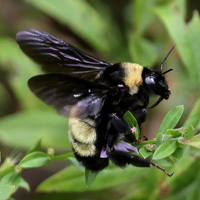American Bumble Bee
Scientific name: Bombus pensylvanicus

Photo credit: Lauren McLaurin CC BY 4.0
Status
Special Concern
“Special concern” means the species lives in the wild in Ontario, is not endangered or threatened, but may become threatened or endangered due to a combination of biological characteristics and identified threats.
Date added to the Species at Risk in Ontario List
January 25, 2023
Read the assessment report (PDF)
What it looks like
The American Bumble Bee is a medium to large-sized bumble bee, with a relatively long head and tongue compared to other bumble bee species in Canada.
The females have distinctive dark wings and yellow and black banding on their abdomens (the section of the body furthest from the head), a pattern that is consistent across the species’ Canadian range. Male bees have longer antennae than the female and have a mostly yellow abdomen with an orange tip.
Where it lives
The American Bumble Bee can be found in a range of open habitats such as:
- farmlands
- meadows
- grasslands
This species usually nests above ground in dense mats of long grasses but has also been known to nest in abandoned rodent burrows and bird nests high above the ground.
Like other bumble bees, American Bumble Bee queens spend the winter underground and in decomposing organic material such as rotting logs and compost.
Southern Ontario and Quebec are at the northern edge of the American Bumble Bee’s distribution, accounting for approximately 2.3% of the species’ global range. Its range broadens further south, where the American Bumble Bee is distributed across the continent from the east coast to Washington state. Southwards, the American Bumble Bee ranges into Mexico, with some specimens recorded from Central America as far south as Costa Rica.
Where it’s been found in Ontario
The American Bumble Bee is present across most of southern Ontario, from southwestern areas such as Windsor to east of Ottawa, mainly within the Mixedwood Plains Ecozone.
What threatens it
The American Bumble Bee is likely threatened due to a combination of factors. This species is susceptible to:
- pesticide use
- habitat loss due to agricultural intensification
- pathogens spillover from domestic bees
It is also thought that the American Bumble Bee has low genetic diversity, possibly contributing to its decline while increasing production of sterile male individuals.
Action we are taking
While special concern species and their habitat do not receive protection under the Endangered Species Act, 2007, the Act requires the preparation of recovery guidance for Special Concern species, unless a recovery strategy or management plan is required for the species under the federal Species at Risk Act.
All species listed on the Species at Risk in Ontario List may be eligible for consideration for government funding through the Species at Risk Stewardship Program.
What you can do
Report a sighting
Submit your observations of species at risk to the Natural Heritage Information Centre (NHIC), which is Ontario’s conservation data centre. Join the “(NHIC) Rare Species of Ontario” project in iNaturalist to make submitting your observations quick and easy.
Volunteer
Volunteer with species at risk programs, such as community science surveys, through your local nature club, a provincial park or other conservation organizations.
Be a good steward
- Private landowners have a very important role to play in species recovery. If you find species at risk on your land, you may be eligible for stewardship programs that support the protection and recovery of species at risk and their habitats, such as the Species at Risk Stewardship Program.
- Pollinators, such as bees, are in steep decline across the globe. They play a key role in the survival of many of Ontario’s rare plants. To learn more about how you can help pollinators, visit Seeds of Diversity.
Report illegal activity
Report any illegal activity related to species at risk to
Quick facts
- The American Bumble Bee is an important pollinator of a variety of native plant species.
- Bumble bees typically fly during inclement weather conditions while other bees and many other winged insects cannot.
- The American Bumble Bee is considered one of the most determined nest-defending bumble bee species, likely because it nests at or above ground.